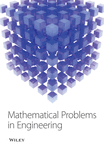Computing Connection Distance Index of Derived Graphs
Abstract
Distance based topological indices (TIs) play a vital role in the study of various structural and chemical aspects for the molecular graphs. The first distance-based TI is used to find the boiling point of paraffin. The connection distance (CD) index is a latest developed TI that is defined as the sum of all the products of distances between pair of vertices with the sum of their respective connection numbers . In this paper, we computed CD indices of the different derived graphs (subdivision graph S(G), vertex-semitotal graph R(G), edge-semitotal graph Q(G) and total graph T(G) obtained from the graph G under various operations of subdivision in the form of degree distance (DD) and CD indices of the basic graphs including some other algebraic expressions.
1. Introduction
A topological index (TI) is a function from the set of simple graphs to the set of real numbers that assigns a unique number to each graph G belonging to . More importantly, it remains constant for the isomorphic graphs that is if G1≅G2 then TI(G1) = TI(G2). Many topological indices have been introduced for the molecular graphs in the chemical graph theory to predict the certain structural and chemical properties such as vaporization, freezing point, boiling point, volume, density, weight and physicochemical properties of chemical bound [1]. Moreover, most rapidly growing fields of science such as chemistry, mathematics and information sciences provide effective research achievements in the last decade and one of the combinations of these subjects is called by cheminformatics which studies two relationships techniques quantitative structures property relationships (QSPR) and quantitative structure activity relationships (QSAR) for the different molecular structures, see [2–4].
Wiener (1947) [5] was first scientist who laid the foundation of chemical graph theory. In chemical graph theory, atoms and bounds are taken as vertices and edges. He discovered through his research work that there is a close correlation between the sums of the distances among pairs of vertices and the boiling points of paraffine. Almost, after passage of three quarters of the 20th century (1972) [6] discovered degree-based indices, (First and Second Zagreb indices), which were utilized to calculate the total π-electron energy of molecules. After these developments, many TIs were introduced which are found to be highly useful for the study of different physicochemical properties of chemical compounds. Degree distance index [7] and Gutman index [8] are the most important distance-degree based TIs. Ali and Trinajstic [9] (2018) restudied the first Zagreb connection index (ZC1), second Zagreb connection index (ZC2) and the modified first Zagreb connection index . Recently, Javaid et al. [10] defined a new distance-based TI called by connection distance index as the sum of all the products of distances between pair of vertices with the sum of their respective connection numbers.
Yan et al. [11] defined the new graphs called as subdivided graph S(G), vertex-total graph R(G), edge-total graph Q(G) and total graph T(G) with the help of the subdivision-related operations S, R, Q and T respectively. Xu et al. [12] have determined the degree distance index of the derived graphs. Bahadur et al. [13] have determined Gutman index of derived graphs. In particular, on different families of graphs for the result about degree based TIs, see [14, 15] (line graph), [16, 17] (sum-graphs), [18, 19] (derived graphs), [20, 21] (extremal graphs), [22, 23] (generalized sum graphs), [24] (nanotube) and distance based TIs, see [25–27].
In this paper, firstly, we have determined the exact values of connection numbers of old (black) vertices and new (white) for derived graph S(G) and bounded values of connection numbers for {C3, C4}− graph of R(G), Q(G) and T(G) were determined. Then, finally, bounded and exact values of connection distance (CD) of derived graphs {S(G), R(G), Q(G), T(G)} are determined by Theorems and Corollaries. Section 2 consists of applications, Section 3 comprises some related definitions, Section 4 covers the main results of connection distance index (CD) for the derived graphs and Section 5 sum up our findings.
2. Applications
From the last two decades, the worth investing problem of finding out the physicochemical properties of the molecular structures is attracting the attention of chemists and mathematicians continuously. The TIs have been used to: predict the solubility of fullerene C60 [28], find the ionic liquids densities [1], optimize QSPR models (Simplex optimisation of generalized TIs) [29], manufacture the anticancer drugs [30, 31], calculate molecular van der Waals areas or volumes [32] and measure the vaporisation, sublimation, formation & combustion for the monocarboxylic acids (C2H4O2 − C20H40O2) [4]. Recently, International Academy of Mathematical Chemistry checked thirteen physicochemical properties of octane isomers (heat capacity at T constant, heat capacity at P constant, density, boiling point, entropy, acentric factor, enthalpy of formation, octanol-water partition coefficient, enthalpy of vaporisation, standard enthalpy of formation, molar volume and total surface tension) with the help of the connection number-based TIs and declared that the chemical capability of the Zagreb connection indices is better than the ordinary Zagreb indices for the entropy and acentric factor of the octane isomers, for detail see [9]. In addition, Javaid et al. [33] presents comparison of correlation coefficients between different TIs and eleven physicochemical properties of octane isomers (boiling point, heat capacity, entropy, density,mean radius, change in heat of vaporization, standard heat of formation, acentric factor, enthalpy of vaporization and standard enthalpy of vaporization) which shows that Gutman connection index is a very useful TI for the prediction of entropy, acentric factor, enthalpy of vaporization and standard enthalpy of vaporization.
3. Preliminaries
- •
The number of vertices at distance one from a vertex ui is called its degree and it is denoted by δ(ui).
- •
Degree of an edge ei = ujuk is given by δ(ei) = δ(uj) + δ(uk) − 2, where 1 ≤ i ≤ m for some 1 ≤ j, k ≤ n.
- •
The distance between two vertices ui, uj ∈ V(G) is denoted by d(ui, uj) and defined as the length of the shortest path between both the vertices ui and uj for 1 ≤ i, j ≤ n.
- •
The distance between two edges ei = upuq and ej = urus is defined as dG(ei, ej) = min{dG(up, ur), dG(up, us), dG(uq, ur), dG(uq, us)}, where 1 ≤ i, j ≤ m and 1 ≤ p, q, r, s ≤ n.
- •
The distance between one vertex ui and one edge ej = upuq is defined as dG(ui, ej) = min{dG(ui, up), dG(ui, uq)}, where 1 ≤ j ≤ m and 1 ≤ i, p, q ≤ n.
- •
The number of vertices at distance two from a vertex ui is called its connection number of ui and it is denoted by τ(ui) for 1 ≤ i ≤ n .
More details about aforesaid definitions can be obtained from [9, 36, 37].
Some important and related TIs are the following:
Definition 1 (see [5].)Let G be a connected graph of order n, then its Wiener index is
Definition 2 (see [6].)Let G be a connected graph of order n, then first and second Zagreb index are defined as
Definition 3 (see [38].)Let G be a connected graph of order n, then first and second Zagreb coindex are defined as
Definition 4 (see [6].)Let G be a connected graph of order n and size m, then edge version of Wiener index is defined as
Definition 5 (see [35].)Let G be a connected graph of order n, then the degree distance index of G is
Definition 6 (see [12].)Let G be a connected graph of order n and size m, then the edge version of degree distance index of G is
Definition 7 (see [8].)Let G be a connected graph, then the Gutman index of G is
Definition 8 (see [10].)Connection Distance index of a graph G (denoted by C D(G)) is defined as
Definition 9 (see [10].)Gutman Connection index of a graph G (denoted by G C(G)) is defines as
Yan et al. [11] defined the four operations S, R, Q and T on the graph G and obtained the four new graphs from G as follows:
- •
S(G) is obtained from G if a new vertex wi is inserted in every edge ei of G. The already existing vertices ui of G are named as old or black vertices while new vertices wi are also named new or white vertices.
- •
R(G) is formed by assigning a new vertex wi corresponding to each edge ei of G and this new vertex wi is connected with the end vertices of the respective edge ei.
- •
Q(G) is formed from S(G) if two white vertices wi and wj are further joined together when corresponding edges ei and ej have one common end vertex.
- •
T(G) is formed from R(G) if two white vertices wi and wj are further joined together when corresponding edges ei and ej have one common end vertex.
4. Relation Between Connection Numbers and Degrees
In order to determine connection numbers or bounded values of connection numbers of derived graphs S(G), R(G), Q(G) and T(G), we will develop Lemma 1 to Lemma 4. Before to the proofs of these results, in particular we consider Figure 1 and Figure 2 to present some trees, cycles and graphs consisting of cycles of order 3 and 4.
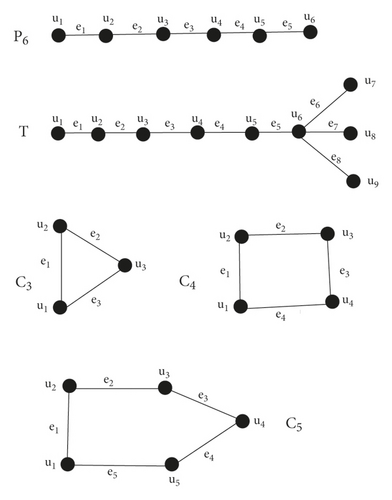
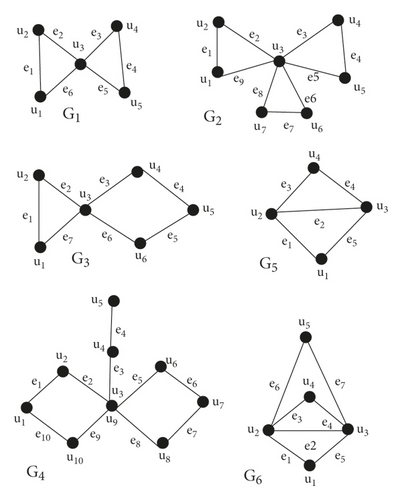
Lemma 1. For a simple and connected graph G (i) τS(G)(ui) = δ(G)(ui) and (ii) τS(G)(wi) = δ(G)(uj) + δ(G)(uk) − 2 = δ(ei) where wi is a new vertex corresponding to edge ei = ujuk.
Proof 1. On applying S-operation, subdivision graph S(G), each vertex ui is connected with δ(G)(ui) = di new (white) vertices. So, δ(G)(ui) = di new (white) vertices wi are at distance one from old vertices ui. Further di old vertices uj are at distance two from ui in S(G) (which are at distance one in G)
Also, each new vertex (white) wi corresponds to each edge ei = ujuk is at distance one from uj and uk. So, number of vertices at distance 2 from wi are δ(G)(uj) − 1 + δ(G)(uk) − 1 (see Figure 3 and Figure 4). Therefore τS(G)(wi) = δ(G)(uj) + δ(G)(uk) − 2 = δ(G)(ei).
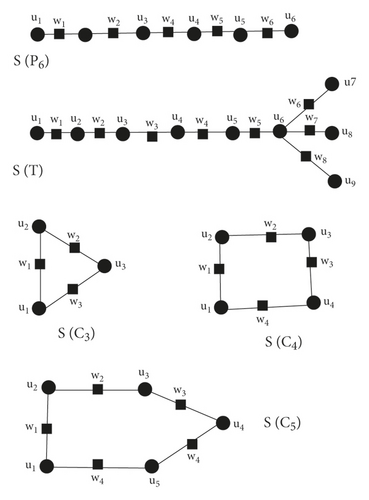
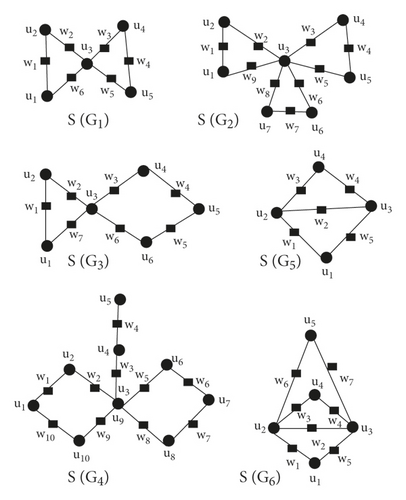
Lemma 2. Let G be a simple and connected graph
- (a)
If G is a {C3, C4}− free graph, then
- (i)
τR(G)(ui) = 2τ(G)(ui) and
- (ii)
τR(G)(wi) = 2[δ(G)(uj) + δ(G)(uk)] − 4 = 2[δ(G)(ei)].
- (i)
- (b)
If G is a {C3, C4}− graph, then
- (i)
τR(G)(ui)⩽2τ(G)(ui) + r, where r = max{ri} and ri are number of C3 and C4 cycles connected with ui in G.
- (ii)
τR(G)(wi)⩽2[δ(G)(uj) + δ(G)(uk)] − 4 − s = 2[δ(G)(ei)] − s, where s = max{si} and si are number of C3 cycles connected with ui in G.
- (i)
Proof 2. On applying R − operation, a new vertex wi is joined with the corresponding vertices of edge ei = ujuk.
Case (a)
If G is a {C3, C4}− free graph, then the degree of each vertex ui in R(G) is twice the degree ui in G i.e. δR(G)(ui) = 2δG(ui) (see Figure 5) . Then their connection number of each vertex ui in R(G) is twice the connection number ui in G i.e. τR(G)(ui) = 2τ(G)(ui). Also uj and uk are at distance one from wi, but in R(G), degree of uj and uk are also doubled, then number of vertices at distance 2 of wi are 2[δ(G)(uj) − 1 + δ(G)(uk) − 1] = 2[δ(G)(uj) + δ(G)(uk)] − 42δG(ei) = 2δG(ei). Also for n ≥ 5, , , , , and = , i = 1,2 … n.
Case (b)
If G is a {C3, C4}− graph, then consider , , and ,= 2δG(ei) − 1 i = 1,2,3.
, , , and = , i = 1,2,3,4.
Consider R(G1) graph in which two C3 are connected by a common vertex u3 as shown in Figure 6, then , ⇒ for i = 1,2,4,5 and , as u3 lies in two C3 graphs. Also = 2δG(ei) − 1 for i = 1,4 and = 2δG(ei) − 1, for i = 2,3,5,6.
Consider R(G2) graph in which three C3 are connected by a common vertex u3 as shown in Figure 6, then , ⇒ for i = 1,2,4,5,6,7 and , as u3 lies in three C3 graphs. Also = 2δG(ei) − 1 for i = 1,4,7 and = 2δG(ei) − 1, for i = 2,3,5,6,8,9.
Consider R(G3) in which one C3 and one C4 are connected by a common vertex u3 as shown in Figure 6, then for i = 1,2,4,5,6, for for for , for , as u3 lies in one C3 and one C4 graphs, , for , Also = 2δG(ei) − 1, = 2δG(ei) − 1, = 2δG(e3), = 2δG(e4).
Consider R(G4) graph in which two C4 graphs and one path are connected by vertex u3 as shown in Figure 6. As for i = 1,2,4,6,8, and , , , , , , , = 2δG(e1), = = = .
Consider a graph R(G5), in which one edge u2u3 is common in two C3 − graphs as shown in Figure 6. and , as N(u1) ∈ two C3 graphs, for i = 1,4, and as N(ui) ∈ C3 graphs, for i = 2,3, = , similarly we can get w2, w3 and w4, = , as u2u3 ∈ two C3 graph.
Now consider a graph R(G6) in which one edge u2u3 is common in three C3 − graphs as shown in Figure 6, and , as N(u1) ∈ three C3 graphs, for i = 1,4,5, and , as N(u1) ∈ three C3 graphs, for i = 2,3, = . Similarly, we can get w3, w4, w5, w6, and w7, = , as u2u3 ∈ three C3 graph.
Now, we close our discussion by taking r = max{ri} and s = max{si}, then upper bound for connection number is taken is taken as τR(G)(ui) = 2τ(G)(ui) + r and τR(G)(wi) = 2[δ(G)(xi) + δ(G)(yi)] − 4 = 2[δ(G)(ei)]. And lower bound for connection number is taken as τR(G)(ui) = 2τ(G)(ui) and τR(G)(wi) = 2[δ(G)(xi) + δ(G)(yi)] − 4 − s = 2[δ(G)(ei)] − s.
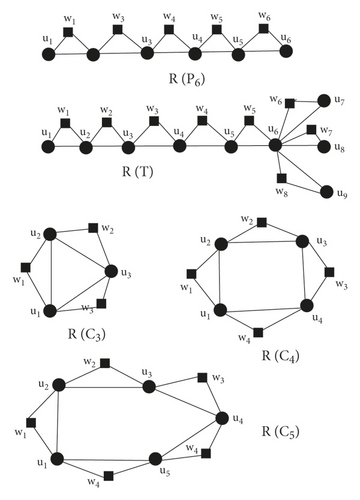
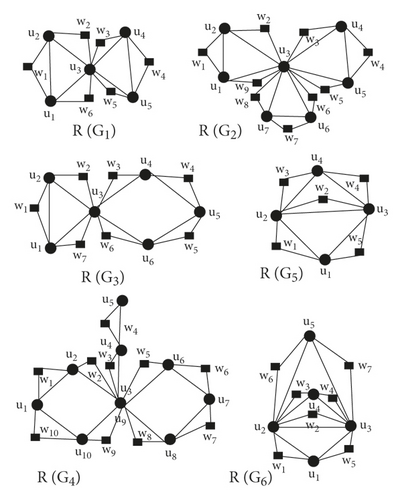
Lemma 3. For a simple and connected graph G,
- (a)
If G is a {C3, C4}− free graph, then
- (i)
τQ(G)(ui) = δ(G)(ui) + τ(G)(ui) and
- (ii)
τQ(G)(wi) = τ(G)(xi) + τ(G)(yi).
- (i)
- (b)
If G is a {C3, C4}− graph, then
- (i)
τQ(G)(ui)⩽δ(G)(ui) + τ(G)(ui) + r where r = max{ri} and ri is the number of C3 and C4 cycles connected with vertex ui .
- (ii)
τQ(G)(wi)⩽τ(G)(uj) + τ(G)(uk) + s where s = max{si} and si is the number of C3 cycles in graph G connected with edge ei.
- (i)
Proof 3. Case (a)
If G is a {C3, C4}− free graph, On applying first S-operation, the connection number of ui becomes equal to . Then for Q-operation, further two new (white) vertices of S(G) are also joined if their corresponding edges have a common vertex between them. So connection number of ui in Q(G) becomes equal to the sum of and τG(ui).
(For explanation from Figure 7, first consider a tree T with nine vertices in which δ(T)(ui) = 1 for i = 1,7,8,9, δ(T)(ui) = 2 for i = 2,3,4,5. δ(T)(u6) = 4, τ(G)(ui) = 1 i = 1,2,6, τ(T)(ui) = 3 i = 3,4, τ(T)(u5) = 4, τ(G)(ui) = 3 i = 7,8,9. Then τQ(T)(u1) = 2 = δ(T)(u1) + τ(T)(u1), τQ(T)(u2) = 3 = δ(T)(u2) + τ(T)(u2), τQ(T)(u3) = 4 = δ(T)(u3) + τ(T)(u3) = τQ(T)(u4), τQ(T)(u5) = 6 = δ(T)(u5) + τ(T)(u5), τQ(T)(u6) = 5 = δ(T)(u6) + τ(G)(u6), τQ(T)(u7) = 4 = δ(T)(u7) + τ(T)(u7) = τQ(T)(u8) = τQ(T)(u9), τQ(T)(w1) = 2 = τ(T)(u1) + τ(T)(u2), τQ(T)(w2) = 3 = τ(T)(u2) + τ(T)(u3), τQ(T)(w3) = τ(T)(u3) + τ(T)(u4), , here we conclude τQ(T)(ui) = δ(T)(ui) + τ(T)(ui) and τQ(G)(Ti) = τ(G)(uj) + τ(T)(uk)).
Also for n ≥ 5, , , , , and τQ(G)(wi) = τ(G)(uj) + τ(G)(uk).
Case(b)
Consider , , and , i = 1,2,3.
, , and τQ(G)(wi) = τ(G)(uj) + τ(G)(uk), i = 1,2,3,4.
Consider Q(G1) graph in which two C3 are connected by a common vertex u3 as shown in Figure 8, then , ⇒ for i = 1,2,4,5 and , as u3 lies in two C3 graphs. Also , but when u1 and u2 is of same degree and u3 is their third vertex in C3, Also for i = 1,4 and , for i = 2,3,5,6.
Consider Q(G2) graph in which three C3 are connected by a common vertex u3 as shown in Figure 8, then , ⇒ for i = 1,2,4,5,6,7 and , as u3 lies in three C3 graphs. Also for i = 1,4,7 but when u1 and u2 is of same degree and u3 is their third vertex in C3, Also for i = 1,4,7 and , for i = 2,3,5,6,8,9.
Consider Q(G3) graph in which one C3 and one C4 are connected by a common vertex u3 as shown in Figure 8, then for i = 1,2,4,5,6, for for for , , as u3 lies in one C3 and one C4 graphs, . Also when u1 and u2 is of same degree and u3 is their third vertex in C3, Also , , .
Consider Q(G4) graph in which two C4 graphs and one path are connected by vertex u3 as shown in Figure 8. As for i = 1,2,4, and , , , , , , , , , , .
Now we consider a graph Q(G5), in which one edge u2u4 is common in two C3 − graphs as shown in Figure 8 . and , as N(u1) ∈ two C3 graphs, for i = 1,3, and as N(ui) ∈ C3 graphs, for i = 2,4, . Similarly, we can get w2, w3 and w4, , as u2u4 ∈ two C3 graph.
Now we consider a graph Q(G6) in which one edge u2u4 is common in three C3 − graphs as shown in Figure 8, and , as N(u1) ∈ three C3 graphs, for i = 1,3,5, and , as N(ui) ∈ three C3 graphs, for i = 2,4, =6. Similarly, we can get w2, w3, w4, w6, and w7, , as u2u4 ∈ three C3 graph.
Now, we close our discussion by taking, r = max{ri} and s = max{si}, τQ(G)(ui)⩽δ(G)(ui) + τ(G)(ui) + r and τQ(G)(wi)⩽τ(G)(uj) + τ(G)(uk) + s.
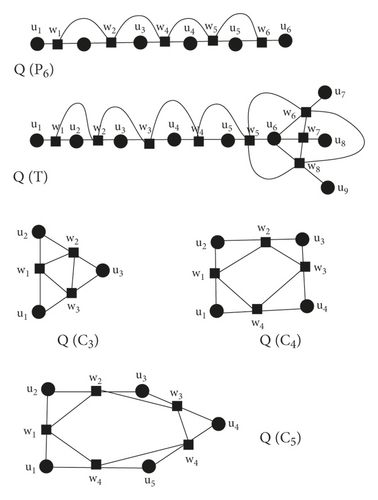
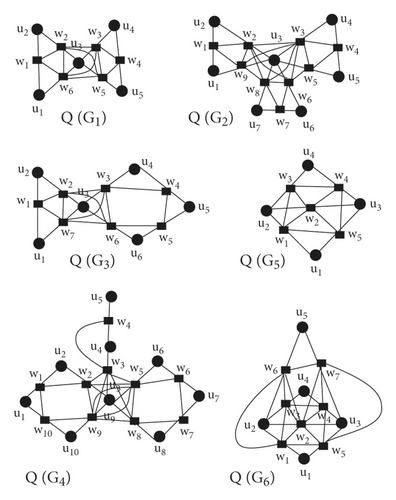
Lemma 4. For a simple, connected graph G,
- (a)
If G is a {C3, C4}− free graph, then
- (i)
τT(G)(ui) = 2τ(G)(ui) and
- (ii)
τT(G)(wi) = τ(G)(uj) + τ(G)(uk).
- (i)
- (b)
If G is a {C3, C4}− graph, then
- (i)
τT(G)(ui)⩽2τ(G)(ui) + r where r = max{ri} and vertex ui is connected with ri number of C3 and C4 cycles and
- (ii)
τT(G)(wi)⩽τ(G)(uj) + τ(G)(uk) + s where s = max{si} and edge ei is connected with the si number of C3 cycles in graph G.
- (i)
Proof 4. After applying T-operation on G, we get m new vertices wi corresponding to each edge ei = ujuk = xiyi for uj = xi, uk = yi.
Case (a)
If G is a {C3, C4}− free graph, on applying first R-operation, the connection number of ui becomes equal to . Then for T-operation, further two new (white) vertices of R(G) are also joined if their corresponding edges have a common vertex between them. So connection number of ui in T(G) becomes equal to the twice of .
(For explanation from Figure 9, first consider for i = 1,6, for for , , here we conclude and
Also for , , , , and τT(G)(wi) = τ(G)(uj) + τ(G)(uk)).
Case (b)
Now consider , , and , i = 1,2,3.
, , and , i = 1,2,3,4.
Consider T(G1) in which two C3 are connected by a common vertex u3 as shown in figure 10, then , ⇒ for i = 1,2,4,5 and , as u3 lies in two C3 cycles. Also , but when u1 and u2 is of same degree 2 and u3 is their third vertex in C3, Also for i = 1,4 and , for i = 2,3,5,6.
Consider T(G2) in which three C3 are connected by a common vertex u3 as shown in Figure 10, then , ⟶ for i = 1,2,4,5,6,7 and , as u3 lies in three C3 graphs. Also for i = 1,4,7 but when u1 and u2 is of same degree 2 and u3 is their third vertex in C3,moreover for i = 1,4,7 and , for i = 2,3,5,6,8,9.
Consider T(G3) in which one C3 and one C4 are connected by a common vertex u3 as shown in Figure 10, then for i = 1,2,4,5,6, for for , , as u3 lies in one C3 and one C4 graphs, , . Also when u1 and u2 are of same degree and u3 is their third vertex in C3, Also , , .
Consider G4 graph in which two C4 graphs and one path are connected by vertex u3 as shown in Figure 10. As for i = 1,2,4, and , , , , , , , , , , .
Now we consider a graph G5, in which one edge u2u4 is common in two C3 − graphs . and , , for i = 1,3, and as ui∈ two C3 cycles, for i = 2,4, . Similarly, we can get w2, w3 and w4, , as u2u4∈ two C3 graph.
Now we consider a graph G6 in which one edge u2u3 is common in three C3 − graphs as shown in Figure 10, and , as N(u1)∈ three C3 graphs, for i = 1,4,5, and as N(ui)∈ three C3 graphs, for i = 2,4, . Similarly, we can get w2, w3, w4, w6, and w7, , as u2u4∈ three C3 graph.
Now, we close our discussion by taking r = max{ri} and s = max{si}, τT(G)(ui)⩽δ(G)(ui) + τ(G)(ui) + r and τT(G)(wi)⩽τ(G)(uj) + τ(G)(uk) + s.
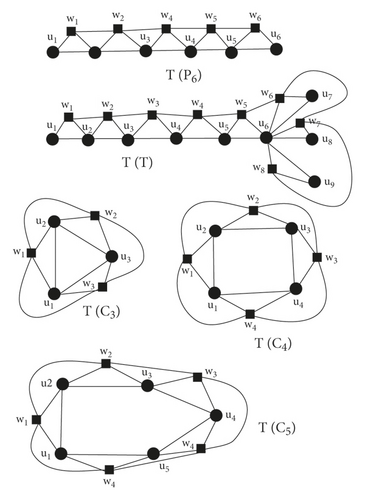
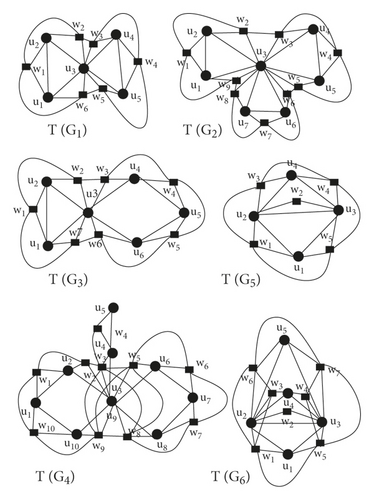
5. Connection Distance Indices of derived graphs
Now, we will determine degree connection sum of derived graphs S(G), R(G), Q(G) and S(G) by the following theorems.
Theorem 1. If S(G) is subdivision graph of G, then
Proof 5. By
lemma 5. τS(G)(ui) = δ(G)(ui) and τS(G)(wi) = δ(G)(uj) + δ(G)(uk) − 2 = τS(G)(ei)
Also
Theorem 2. If G be a {C3, C4}− graph and R(G) is an vertex-semitotal graph of G, then
Proof 6.
- (a)
For upper bounds, we take by lemma 2, τR(G)(ui) = 2τ(G)(ui) + r and τR(G)(wi) = δ(G)(uj) + δ(G)(uk) − 2 = δG(ei).
Also dR(ui, uj) = dG(ui, uj), for ui, uj ∈ V(G). dR(wi, wj) = dG(ei, ej) + 2, for ei, ej ∈ E(G). dR(ui, wj) = dG(ui, ej) + 1, for ui ∈ V(G) and ej ∈ E(G).
For lower bounds, by
lemma 6. τR(G)(ui) = 2τ(G)(ui) and τR(G)(wi) = [δ(G)(uj) + δ(G)(uk) − 2] − s = δG(ei) − s.
If G is {C3, C4}− free graph, then connection distance index (CD)of R(G) can also be determined by taking r = 0 and s = 0 in Theorem 2.
Corollary 1. If G be a {C3, C4}− free graph,then
Theorem 3. If Q(G) is an edge-semitotal graph of G, then
Proof 7. By
lemma 7. τQ(G)(ui)⩽δG(ui) + τG(ui) + r and τQ(G)(wi)⩽τ(G)(uj) + τ(G)(uk) + s.
To avoid confusion, we take edge ei = xiyi = ujuk for some j and k, then τQ(G)(wi)⩽τ(G)(xi) + τ(G)(yi) + s. Also
If G is {C3, C4}− free graph, then connection distance index (CD) of Q(G) can also be determined by taking r = 0 and s = 0 in Theorem 3.
Corollary 2. If G is a {C3, C4}− free graph, then
Theorem 4. If T = T(G) is an total graph of G, then
Proof 8. To avoid confusion, we take edge ei = xiyi = ujuk for some j and k. By lemma 4, τT(G)(wi)⩽τ(G)(xi) + τ(G)(yi) + s and τT(G)(ui) = 2τG(ui) + r
Also
If G is {C3, C4}− free graph, then connection distance index (CD) of T(G) can also be determined by taking r = 0 and s = 0 in Theorem 4.
Corollary 3. If G is a {C3, C4}− free graph, then
6. Conclusion
In previous section, first of all, connection numbers of old (black) vertices and new (white) were determined for derived graph F(G) where F ∈ {S, R, Q, T} (by Lemma 1, Lemma 2,Lemma 3 and Lemma 4 ) . It was found that exact values of connection numbers for {C3, C4}− free graph and S(G) were determined. Bounded values of R(G), Q(G) and T(G) for {C3, C4}− graphs were determined. Then, finally, exact and bounded values of connection distance (CD) of derived graphs {S(G), R(G), Q(G), T(G)} were determined by Theorems and Corollaries. International Academy of Mathematical Chemistry declared better reports for the chemical capability of the Zagreb connection indices than the ordinary Zagreb indices for the entropy and acentric factor of the octane isomers.
Conflicts of Interest
The authors declare no conflicts of interest.
Open Research
Data Availability
The whole data are included within this article. However, the reader may contact the corresponding author for more details on the data.



